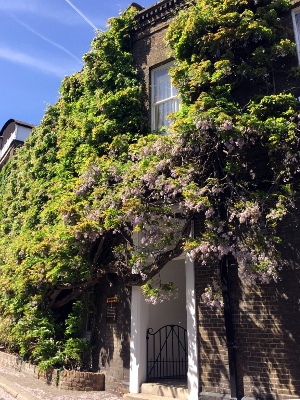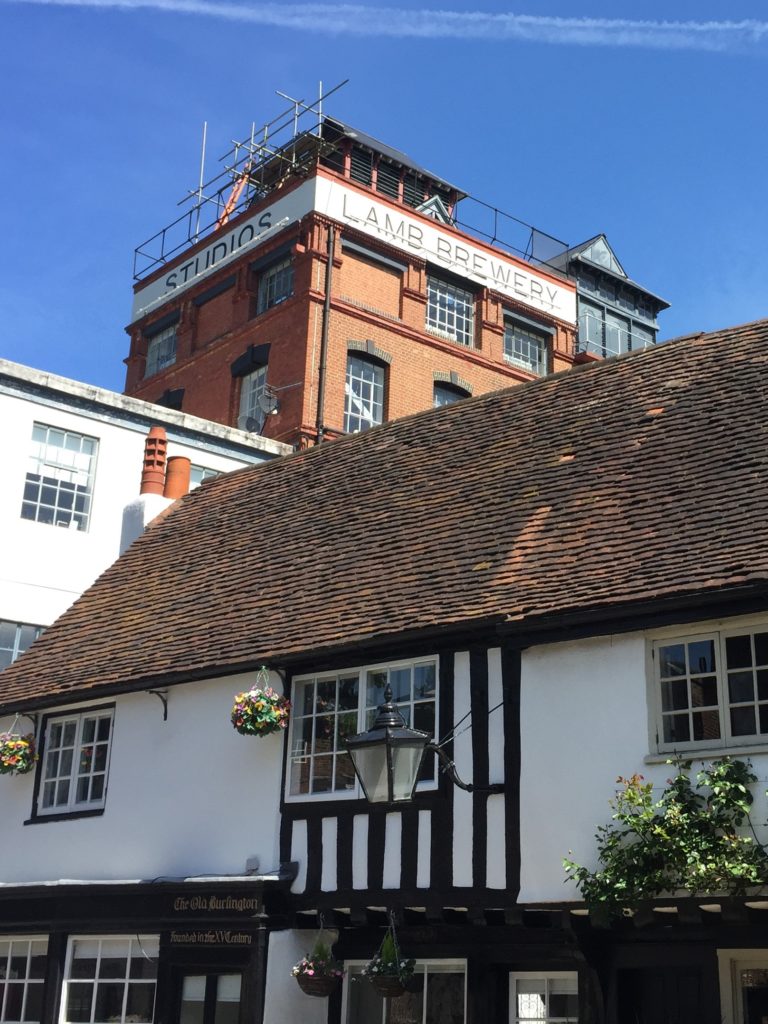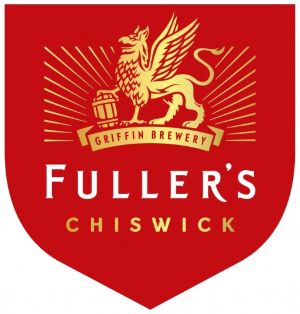Formerly Fuller, Smith & Turner. Includes information for the original Lamb Brewery
Brewery
Chiswick Lane South W4 2QB (Hounslow)
fullersbrewery.co.uk
First sold beer: 1701 (as Mawson’s)
Shockwaves ran through the London brewing scene on 25 January 2019 when Fuller, Smith & Turner, London’s biggest brewery and its oldest by far, announced it was following in the footsteps of former fellow London brewer Young’s and many other old-established UK family breweries by ditching brewing to concentrate on pubs.
The beer business, including the historic Griffin brewery, was sold for £250 million to Asahi of Japan, becoming its second brewery in London after Meantime, while Fuller’s shifted focus to its pub estate, where 87% of its profit had been generated. Asahi has undertaken to continue brewing at the Griffin, which is now London’s only historic brewery in continuous commercial production: all the others were founded or revived in the 21st century.

Brewing on this riverside site on Chiswick Mall can be traced back to the 1650s domestic brewery attached to stately home Bedford House on Chiswick Mall. Thomas Mawson founded the Griffin brewery as a commercial operation in 1701, and the Fuller family became involved in 1829. The currently quoted founding date of 1845 is when a new partnership took over, involving John Bird Fuller, Henry Smith (formerly of Ind & Smith in Romford, later Ind Coope), and John Turner.
Fuller Smith & Turner became a limited company in 1929. Descendants of the original partners remained involved until the recent sale and retain their position in the successor pub company.
As one of only two independent breweries left in London as the beer consumer movement gathered pace in the 1970s, Fuller’s was persuaded not to convert to keg production and to revive traditional cask conditioning and handpump dispense. It grew substantially from an output of around 100,000 hl and an estate of 100 pubs to 550,000 hl and 400 pubs just before the Asahi deal.

In 2005, Fuller’s bought another old-established family brewer, Gales in Horndeam, Hampshire, and closed it the following year, retaining some of the brands. In February 2018, the brewery bought Dark Star, based in Partridge Green near Horsham, West Sussex, with the intention of retaining it as a working brewery, though its flagship Hophead was soon shifted to Chiswick. Both these assets were included in the Asahi deal.
Dark Star’s roots go back to London in 1982 when Pitfield’s Brewery was founded by microbrewing pioneers Rob Jones and Martin Kemp in Pitfield Street, Hoxton. Their best-known beer was a porter called Dark Star which became the first microbrew to win Champion Beer of Britain in 1987, and when in 1994 Rob collaborated with the landlord of the Evening Star pub in Brighton to set up a microbrewery in the cellar, he revived the name.
Dark Star played a major role in popularising the use of New World hops in the UK and expanded twice before the Fuller’s acquisition, though Rob left in 2016. Sadly, Asahi opted to close Dark Star in December 2022. Originally, its brands other than Hophead transferred to Meantime, though that brewery is also due to close in 2024, with all production centred at Chiswick.
Fuller’s brewhouse was renewed in the mid-1990s with a modern twin mash tun system which brews in 520 hl batches, and nearly all fermentation is now in cylindro-conical closed fermenters. In July 2018 a new 16 hl pilot brewery was installed as part of a major refurbishment of the visitor centre. Drink-in facilities here were added in 2021, replacing longstanding brewery tap the Mawson Arms around the corner. World-renowned brewing director John Keeling retired in October 2018 though still acts as a brewery ambassador.
Under the new arrangement, the Griffin still supplies beers to Fuller’s pubs, while Asahi is free to use Fuller’s trademarks to market the beer elsewhere. The Japanese company has said it respects the brands and their heritage and is particularly keen to increase international sales. But the deal has inevitably raised worries about the future of the site, which given its location could be extremely valuable if redeveloped.
Beers are in cask, keg, can, bottle conditioned and in filtered bottles, with some minicasks. Several of the core brands are related through the technique of ‘parti-gyling’, taking multiple runnings at different gravities from the same basic mash and tweaking the hop additions. All Fuller’s-branded beers are fermented using a longstanding house yeast, while Gale’s and Dark Star beers use different yeasts.
Things to see
As London’s only remaining working historic brewery and on an attractive riverside site in the Old Chiswick Conservation Area, Fuller’s is particularly worth a visit. It’s possible to view some of the historic buildings from the street or the non-gated section of the brewery yard. The site with its prominent branding provides a landmark on the busy Great West Road (A4) on the approach to the Hogarth Roundabout, so called because artist and illustrator William Hogarth (1697-1794), well-known to brewing historians for his satirical diptych of Gin Lane and Beer Street, lived in a house nearby, now open as a visitor attraction.
The brewery’s current main entrance with its decorative ironwork opens onto Mawson Lane, the sliproad parallel to the main road on its south side, with several late Victorian industrial buildings visible. The corner building to the left forms one end of a terrace of five town houses which continue round the corner along Chiswick Lane South (110-118, W4 2QA), built around 1715 for brewery founder Thomas Mawson and now Grade II* listed. The poet Alexander Pope (1688-1744) lived at the corner building between 1716-1719 and is commemorated with a blue plaque. The small two-storey Grade II-listed Garden House, which presents a gable end to Mawson Lane just to the right, may have been built for him, though was much altered in the 19th century.
Around 1897, the corner house was converted to a brewery tap, initially the Fox and Dogs, later the Fox and Hounds. It then acquired a second name, the Mawson Arms, though both names continued in use, perhaps as a legacy of two sections of the pub having separate ale and spirits licenses. On the deal with Asahi, the pub remained with the legacy pub company, who opted not to reopen it following the 2020 lockdowns, though it was advertised as to let in 2024 so may yet reopen under a new operator.
Along Chiswick Lane South you pass the brewery shop and visitor centre, with the pilot brewery visible behind glass at the back. This is the starting point for the highly recommended brewery tours (book in advance, charge payable). Further along is the particularly attractive cobbled yard with a terrace of three 18th century houses (130-134 Mawson Row) wrapped around the corner.
A little further into the yard on the right is the Brewer’s House, actually built as the owner’s house sometime in the 18th century and later used as offices and a boardroom. The wisteria climbing its walls was grown from the earliest cuttings to arrive in Britain from China in 1816: another cutting went to Kew Gardens but died. Opposite is the Hock Cellar, a former wines and spirits store named after the brewery’s mild ale, now used as part of the visitor experience. It’s an atmospheric space with numerous interesting exhibits but is usually only open to guests on brewery tours.
The rest of the site is also only accessible to tour guests. Although today the brewery uses almost entirely modern equipment, numerous pieces of vintage kit have been retained. The oldest vessel is an 1823 domed London copper with calandria, embedded in brick. Other highlights include 1930s grist mills which are still in use, an 1863 mash tun with an unusual segmented copper lid, a smaller Victorian copper once used for melting brewing sugar, and a double drop fermenter with a round wooden vessel arranged over a copper square equipped with a water-based attemperator.
The small buildings by the directors’ car park now used for technical services are some of the earliest on the site, predating commercial brewing: they originated as outbuildings for the houses fronting Chiswick Mall.
Back in the public realm, continuing along Chiswick Lane South towards the river Thames you pass a succession of brewery walls and buildings on the right. Turn right to follow the Thames Path upstream along Chiswick Mall, where numerous grand houses, many of them listed, back onto the brewery’s southern perimeter. Two adjoining imposing Grade II*-listed mansions, Eynham House and Bedford House (W4 2PJ), are set a little back from the street about halfway along to the next junction. Originally a single property occupied this plot, Bedford House, built for the Russell family, earls (later dukes) of Bedford, around 1650. Brewing began in an outbuilding at the rear of this, perhaps one of those still in brewery use for technical services. The house was rebuilt in the early 18th century and split into two. Note that particularly high tides sometimes render Chiswick Mall impassable.
Turning away from the river again at the next corner along Church Street, you pass Grade II*-listed St Nicholas Church on the left. This early 14th century parish church was rebuilt 1882-84 with funds largely donated by brewery partner Henry Smith. Hogarth is buried in the churchyard.
A little further along on the right, set back from Church Street around a narrow yard (W4 2PD), are the remains of a second Chiswick brewery, the Lamb, dating from at least the 1770s and once at least as big as the Griffin. Since at least 1790 it was owned and operated by the Sich family and was later known as Sich & Co. In the 1850s some of the family lived in Bedford House. The tower brewhouse built around 1900 still stands, though hasn’t brewed since 1920 when Sich & Co merged with the Isleworth Brewing Company, later absorbed by Watney.
The Lamb site was subsequently used by Fuller’s for storage and later by the Standard Yeast Company but is now offices. The pretty 18th century pink stucco and weatherboard building on the left corner here, now known as Burlington Corner, is the former Lamb brewery tap and likely where brewing began on the site. On the opposite corner is a charming 16th-century timber-framed building, The Old Burlington, one of the oldest in the area. This was also once a pub, the Burlington Arms, but both it and the Lamb lost their licenses in 1924 following the brewery closure.
The Lamb name was briefly reused between 2012-13 for a brewpub in central Chiswick: see Brewhouse and Kitchen.
Updated 21 May 2024.






Leave a Reply